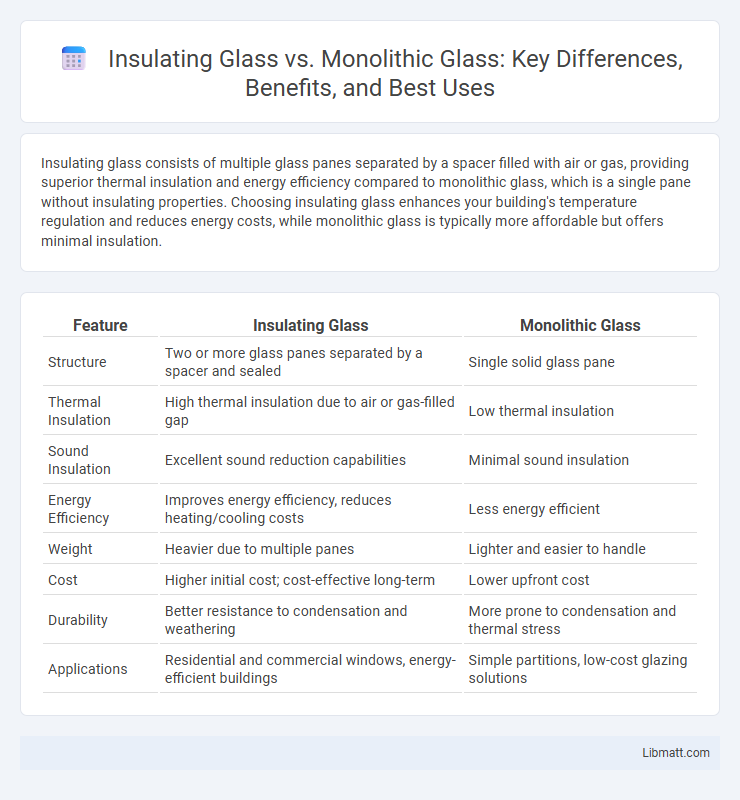Insulating glass consists of multiple glass panes separated by a spacer filled with air or gas, providing superior thermal insulation and energy efficiency compared to monolithic glass, which is a single pane without insulating properties. Choosing insulating glass enhances your building's temperature regulation and reduces energy costs, while monolithic glass is typically more affordable but offers minimal insulation.
Table of Comparison
| Feature | Insulating Glass | Monolithic Glass |
|---|---|---|
| Structure | Two or more glass panes separated by a spacer and sealed | Single solid glass pane |
| Thermal Insulation | High thermal insulation due to air or gas-filled gap | Low thermal insulation |
| Sound Insulation | Excellent sound reduction capabilities | Minimal sound insulation |
| Energy Efficiency | Improves energy efficiency, reduces heating/cooling costs | Less energy efficient |
| Weight | Heavier due to multiple panes | Lighter and easier to handle |
| Cost | Higher initial cost; cost-effective long-term | Lower upfront cost |
| Durability | Better resistance to condensation and weathering | More prone to condensation and thermal stress |
| Applications | Residential and commercial windows, energy-efficient buildings | Simple partitions, low-cost glazing solutions |
Introduction to Insulating and Monolithic Glass
Insulating glass consists of two or more glass panes separated by a spacer filled with air or inert gas, improving thermal efficiency and sound insulation compared to monolithic glass, which is a single pane of glass. Your choice between insulating and monolithic glass will impact energy savings, noise reduction, and overall building comfort. Insulating glass provides superior protection against heat loss and condensation, making it ideal for modern energy-efficient windows.
Composition and Structure Comparison
Insulating glass consists of two or more glass panes separated by a spacer filled with air or inert gas, creating a thermal barrier that reduces heat transfer. Monolithic glass is a single, solid pane without any internal layers or spacers, offering minimal insulation properties. The multi-layered structure of insulating glass enhances energy efficiency and sound insulation compared to the uniform composition of monolithic glass.
Thermal Insulation Performance
Insulating glass, composed of two or more glass panes separated by a spacer filled with inert gas, provides superior thermal insulation compared to monolithic glass by significantly reducing heat transfer through conduction and convection. The low-emissivity coatings often applied to insulating glass further enhance its thermal performance by reflecting infrared radiation, helping maintain indoor temperature stability. Monolithic glass, being a single pane without these features, allows higher heat exchange, resulting in greater energy loss and reduced comfort in buildings.
Energy Efficiency Differences
Insulating glass, comprised of two or more glass panes separated by an air or gas-filled space, significantly enhances energy efficiency by reducing heat transfer and improving thermal insulation compared to monolithic glass, which is a single pane. The air or gas layer acts as a barrier to heat flow, resulting in lower U-values and better resistance to temperature fluctuations, leading to reduced heating and cooling costs. Monolithic glass, lacking this insulating layer, exhibits higher thermal conductivity and less effective energy performance, making it less suitable for energy-conscious building designs.
Acoustic Insulation Capabilities
Insulating glass, composed of two or more glass panes separated by a spacer filled with air or gas, offers significantly enhanced acoustic insulation capabilities compared to monolithic glass, which is a single pane. The multiple layers and the gas-filled gap in insulating glass reduce sound transmission by dampening vibrations and creating a sound barrier, making it ideal for noisy environments. If you want to improve your space's noise reduction, choosing insulating glass over monolithic glass will provide superior acoustic comfort.
Durability and Lifespan
Insulating glass features multiple layers separated by an air or gas-filled space, significantly enhancing its durability and lifespan compared to monolithic glass, which consists of a single glass pane. The added layers in insulating glass reduce the risk of breakage and provide better thermal performance, extending the window's functional life. If you seek long-term efficiency and resilience, insulating glass offers superior durability over monolithic options.
Cost Considerations
Insulating glass typically incurs higher upfront costs compared to monolithic glass due to its multi-pane construction and added features like gas fills and low-emissivity coatings that enhance energy efficiency. Monolithic glass, being a single pane, is more cost-effective initially but may lead to increased energy expenses over time because of its lower insulation properties. Long-term savings from reduced heating and cooling costs often justify the higher investment in insulating glass for residential and commercial applications.
Applications in Architecture
Insulating glass, consisting of two or more glass panes separated by a gas-filled space, is widely used in architectural applications to enhance thermal insulation, reduce energy consumption, and improve acoustic performance in commercial and residential buildings. Monolithic glass, a single pane, is typically employed in applications requiring impact resistance, safety glazing, or minimal cost, such as storefronts or interior partitions. The choice between insulating and monolithic glass depends on building codes, climate considerations, and desired energy efficiency in architectural projects.
Environmental Impact and Sustainability
Insulating glass significantly reduces energy consumption by improving thermal insulation, which lowers heating and cooling demands, thereby decreasing your carbon footprint. Monolithic glass lacks this energy efficiency, causing higher energy use and greater environmental impact over time. Choosing insulating glass supports sustainability by enhancing energy savings and reducing greenhouse gas emissions in construction.
Choosing the Right Glass for Your Project
Choosing the right glass for your project depends on factors such as thermal performance, sound insulation, and budget constraints. Insulating glass, composed of two or more panes separated by a spacer and sealed, offers superior energy efficiency and noise reduction compared to monolithic glass. Monolithic glass, being a single solid pane, is often preferred for applications requiring simplicity and cost-effectiveness but lacks the insulation benefits of insulating glass.
insulating glass vs monolithic glass Infographic

 libmatt.com
libmatt.com